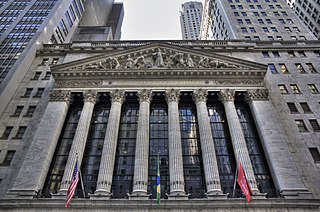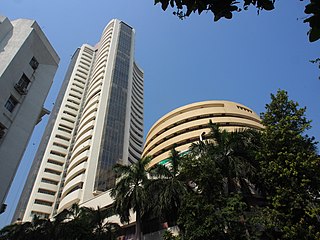
NYSE American, formerly known as the American Stock Exchange (AMEX), and more recently as NYSE MKT, is an American stock exchange situated in New York City. AMEX was previously a mutual organization, owned by its members. Until 1953, it was known as the New York Curb Exchange.

The New York Stock Exchange is an American stock exchange in the Financial District of Lower Manhattan in New York City. It is the largest stock exchange in the world by market capitalization.

A stock exchange, securities exchange, or bourse is an exchange where stockbrokers and traders can buy and sell securities, such as shares of stock, bonds and other financial instruments. Stock exchanges may also provide facilities for the issue and redemption of such securities and instruments and capital events including the payment of income and dividends. Securities traded on a stock exchange include stock issued by listed companies, unit trusts, derivatives, pooled investment products and bonds. Stock exchanges often function as "continuous auction" markets with buyers and sellers consummating transactions via open outcry at a central location such as the floor of the exchange or by using an electronic trading platform.

London Stock Exchange (LSE) is a stock exchange in the City of London, England, United Kingdom. As of August 2023, the total market value of all companies trading on the LSE stood at $3.18 trillion. Its current premises are situated in Paternoster Square close to St Paul's Cathedral in the City of London. Since 2007, it has been part of the London Stock Exchange Group. The LSE was the most-valued stock exchange in Europe from 2003 when records began until Autumn 2022, when the Paris exchange overtook it. According to the 2020 Office for National Statistics report, approximately 12% of UK-resident individuals reported having investments in stocks and shares. According to the 2020 Financial Conduct Authority (FCA) report, approximately 15% of UK adults reported having investments in stocks and shares.

Philadelphia Stock Exchange (PHLX), now known as Nasdaq PHLX, is the first stock exchange established in the United States and the oldest stock exchange in the nation. The exchange is owned by Nasdaq, which acquired it in 2007 for $652 million, and is headquartered in Philadelphia.

BSE Limited, also known as the Bombay Stock Exchange, is an Indian stock exchange which is located on Dalal Street in Mumbai. Established in 1875 by cotton merchant Premchand Roychand, it is the oldest stock exchange in Asia, and also the tenth oldest in the world. The BSE is one of the world's largest stock exchanges by market capitalization with a market cap of US$ 3.8 trillion as of June 2023.

Clarence W. Barron was one of the most influential figures in the history of Dow Jones & Company. As a career newsman described as a "short, rotund powerhouse", he died holding the posts of president of Dow Jones and de facto manager of The Wall Street Journal. He is considered the founder of modern financial journalism.

Nasdaq, Inc. is an American multinational financial services corporation that owns and operates three stock exchanges in the United States: the namesake Nasdaq stock exchange, the Philadelphia Stock Exchange, and the Boston Stock Exchange, and seven European stock exchanges: Nasdaq Copenhagen, Nasdaq Helsinki, Nasdaq Iceland, Nasdaq Riga, Nasdaq Stockholm, Nasdaq Tallinn, and Nasdaq Vilnius. It is headquartered in New York City, and its president and chief executive officer is Adena Friedman.

Budapest Stock Exchange(BSE) (Hungarian: Budapesti Értéktőzsde (BÉT)) is the 2nd largest stock exchange in Central and Eastern Europe by market capitalization and liquidity. It is located at 55 Krisztina Boulevard, Budapest, Hungary, in the Buda Centre of the Hungarian National Bank Previously, from 1864, during the Austro-Hungarian Empire it was located in the Budapest Stock Exchange Palace building, until a large trading floor was necessary. The exchange is controlled by listed issuers, by Hungarian private investors and by the central bank. The BSE is member of the World Federation of Exchanges and the Federation of European Securities Exchanges.
PaineWebber & Co. was an American investment bank and stock brokerage firm that was acquired by the Swiss bank UBS in 2000. The company was founded in 1880 in Boston, Massachusetts, by William Alfred Paine and Wallace G. Webber. Operating with two employees, they leased premises at 48 Congress Street in May 1881. The company was renamed Paine, Webber & Co. when Charles Hamilton Paine became a partner. Members of the Boston Stock Exchange, in 1890 the company acquired a seat on the New York Stock Exchange. Wallace G. Webber retired after the business weathered a major financial crisis of 1893.

Broad Street is a north–south street in the Financial District of Lower Manhattan in New York City. Originally the Broad Canal in New Amsterdam, it stretches from today's South Street to Wall Street.

The Phiroze Jeejeebhoy Towers, popularly known by its original name of BSE Towers, is a 29-storey building in downtown Mumbai on Dalal Street, near its intersection with the Mumbai Samachar Marg. The building is owned and occupied by the Bombay Stock Exchange (BSE). BSE has secured a trademark for its iconic building.

Thomas Marshall Howe was a Whig member of the U.S. House of Representatives from Pennsylvania. He was a financier, statesman, manufacturer, and philanthropist. He was considered the leading citizen of Pittsburgh of his day.

Thomas Peterffy is a Hungarian-born American billionaire businessman. He is the founder, chairman, and the largest shareholder of Interactive Brokers. Peterffy worked as an architectural draftsman after emigrating to the United States, and later became a computer programmer. In 1977, he purchased a seat on the American Stock Exchange and played a role in developing the first electronic trading platform for securities. Forbes's 2023 list of The World's Billionaires estimated his net worth at US$25.3 billion, making him the 57th richest man in the world.
In corporate finance, a listing refers to the company's shares being on the list of stock that are officially traded on a stock exchange. Some stock exchanges allow shares of a foreign company to be listed and may allow dual listing, subject to conditions.

The Merchants Exchange building (1842-1890) in Boston, Massachusetts was built in 1841 from a design by architect Isaiah Rogers. Centrally located on State Street, it functioned as a hub for business activities in the city.
Peter Paul Francis Degrand (1787–1855) or P.P.F. Degrand was a French-born broker and merchant in Boston, Massachusetts, in the 19th century.
The Bremen Exchange in Bremen was one of the eight German Regional stock exchanges until 2007. In 2000 it ceased to use the Open outcry method and in 2007 the last operative units were closed. The property of exchange's holding company went to the newly established Foundation of the Bremen Stock Exchange, a non-profit organisation which is intended to benefit scholarship, research, and culture.

Interactive Brokers LLC (IB) is an American multinational brokerage firm. It operates the largest electronic trading platform in the United States by number of daily average revenue trades. The company brokers stocks, options, futures, EFPs, futures options, forex, bonds, funds, and some cryptocurrencies.
Murray Roberts Ballou was an American financier who led the Boston Stock Exchange from 1870 to 1900.






















